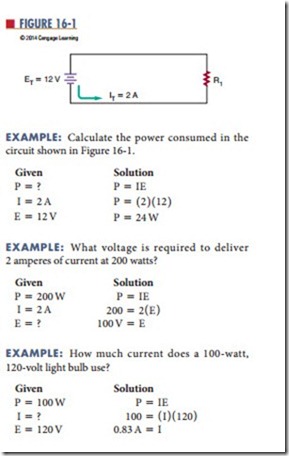Power
Electrical or mechanical power relates to the rate at which work is being done. work is done whenever a force causes motion. If a mechanical force is used to lift or move a weight, work is being done. However, force exerted without causing motion, such as a force of a compressed spring between two fixed objects, does not constitute work.
Voltage is an electrical force that creates current to flow into a closed circuit. When voltage exists between two points and current cannot flow, no work is done.
This is similar to a spring under tension that produces no motion. When voltage causes electrons to move in a circuit, work is being done. The instantaneous rate at which work is done is called the electric power rate and is measured in watts. Power can be defined at the rate which energy is dissipated in a circuit. The symbol for power is P.
The total amount of work done may be accomplished in different lengths of time. For example, a given quantity of electrons may be moved from one location to another in one second, one minute, or one hour, depending on the rate in which they were moved. In all cases, the total amount of work done is the same. However, when the work is done in a short period of time, the instantaneous power rate (wattage) is greater than when the same amount of work is done over a longer period of time.
As mentioned, the basic unit of power is the watt. A watt is equal to the voltage across a circuit multiplied by the current through the circuit. It represents the rate at any given instant in which work is being done, moving electrons through the circuit. The relation- ship of power, current, and voltage may be expressed as follows:
I represents the current through the circuit and E represents the voltage applied to the circuit being measured. The amount of power will differ with any change in the voltage or current in the circuit.
Questions
1. Define power as it relates to electricity.
2. What unit is used to measure power?
3. What represents the rate of work being done at any given instant?
4. When the same work is being done at different lengths of time, is the total amount of work done the same?
